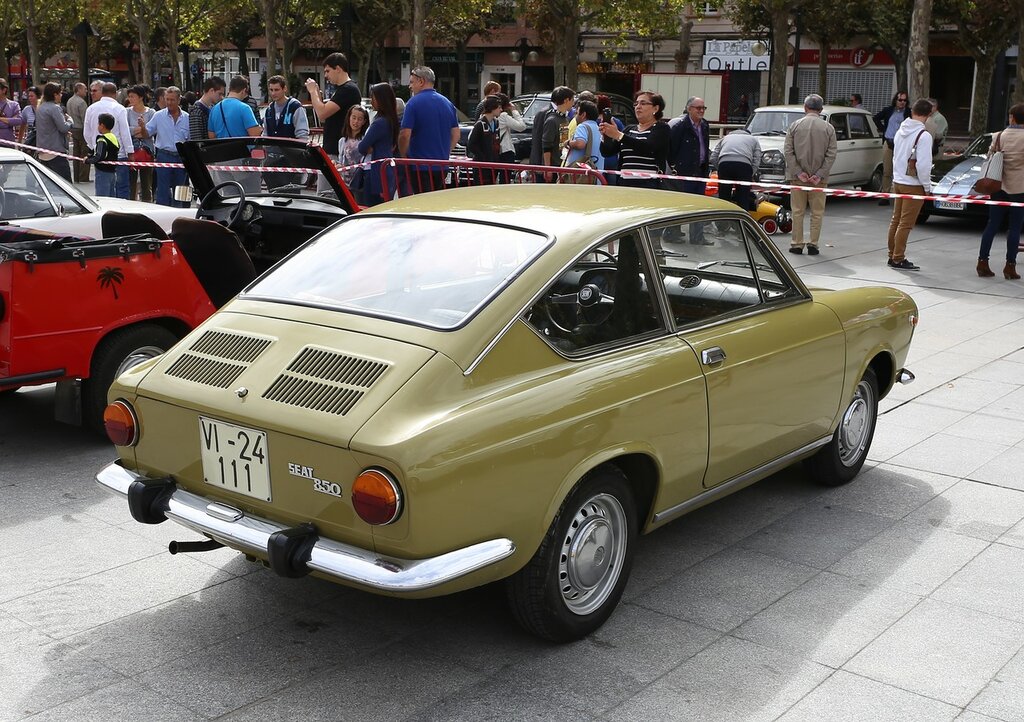SEAT on Oldtimer Parade in Logroño
The history of the Spanish car industry dates back to 1919, when Spain's first car factory opened in the suburbs of Barcelona. The production was owned by the Italian company Fiat. The
national car brand appeared in the country only in 1950, when the
"Spanish community of passenger cars for tourism" (Sociedad Española de
Automóviles de Turismo), or abbreviated SEAT, was established. The
first factory of the company was located again in Barcelona, and the
first model SEAT-1400 was a copy of the "Fiat" with the same index. Nothing surprising here, the famous Italian company was one of the main shareholders of the new car factory. The
first cars came out of the gate on November 13, 1953, collected them
for 5 pieces a day from ready-made parts and assemblies made in Italy. However, a year later, 93% of the components were produced in Spain, and production reached 42 cars per day.

The car of the first editions had a 44-horsepower engine and drove at speeds up to 116 km/h. The
next modification, the 1400A, had a power of 50 HP, which allowed it to
accelerate to 125 km/h, and the 1400B was more powerful by another 8 HP
and went 10 km / h faster. The car was produced until 1963.

The next SEAT model was again a Fiat, this time a subcompact model 600, which became a truly popular car. The car went down in history as one of the sieves of El Milagro español, the "Spanish miracle", the economic boom of 1959-1974.

The Fiat 600 was positioned as a "city car", but became incredibly popular due to its low price and ease of operation. The car was equipped with four-cylinder air-cooled engines of 19 and 21.5 HP.

The car was produced in Italy from 1955 to 1969, 2,695,197 units were produced. Clones were introduced in the seventies in the USSR and Yugoslavia, and in Latin America even in the eighties.

The SEAT 600 was produced in Barcelona from may 1957 to August 1973, with a total of 797,319 cars produced.

The factory provided not only the needs of the domestic market, but also exported cars to Argentina, Mexico, Poland and Finland.

One of the reasons for stopping production, despite
the high demand, was due to safety concerns - it was not possible to
install safety belts in the existing design of the body racks.

The Fiat 850 was introduced in 1956 as a replacement for the popular Fiat 600 subcompact. It was also a compact rear-wheel drive car. The car had no major technological differences from its predecessor, except for a more attractive appearance. The engine was also practically the same, only increased volume. Two modifications were offered - the "standard" with a power of 34 HP and the "super" with 37 HP.

In
addition to the basic model, several modifications were produced -
Special, which was slightly better in comfort and interior trim,
Familiare ( family) - an elongated version with three rows of seats,
accommodating 5 adults and 2 children, as well as sports variants of the
Coupe (pictured) and the Spider convertible. These cars were distinguished by more powerful engines-47 and 49 HP, respectively, so they could reach speeds of up to 135 km/h.

From 1966 to 1974, these cars were produced in
Spain under the name SEAT 850, the Coupe model went off the Assembly
line in Barcelona in 1967-1970.

The SEAT 1500, a Spanish version of the Italian Fiat 1500L, was produced from 1963 to 1972. The car's design was developed by the famous Pininfarina body shop. In addition to SEAT, the car was also produced at the Zastava plant in Yugoslavia.

In
Spain, in addition to the standard 1.5-liter carburetor engine, a
modification with a 2-liter diesel Mercedes-Benz 180 was produced, which
was used mainly as a taxi. The diesel version accelerated to 100 km / h for
almost 50 seconds, but significant fuel economy more than covered this
shortcoming.

The
four-seat SEAT 1200 Sport coupe was first introduced in December 1975,
and was produced from December 1976 to September 1979. The
prototype was again the Fiat 127, but the Spanish car was equipped with
a more powerful engine of 67 HP, which allowed it to accelerate to 160
km/h. The car is popularly known as the Bocanegra ("Black mouth") because of its plastic front panel. Perhaps this was one of the reasons for the low demand, so production was quickly curtailed.

